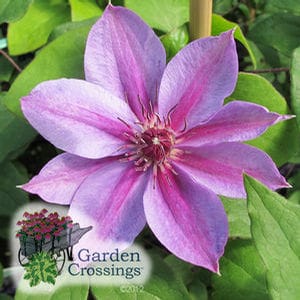Clematis Care Tips
Where do you find that unusual clematis vine for your mailbox or arbor garden? At Garden Crossings! We have dozens of Clematis varieties, including many that you can’t find anywhere else. Don’t settle for common clematis, when you can enjoy exquisite climbing vines with bell-shaped, fringed, or double-flowering blooms. While vines with flowers in shades of purple are common, we also have pink, burgundy, white, and even yellow flowered clematis. Keep clematis color in your garden all year with spring and fall flowering varieties. Don’t have a lot of room for a clematis vine? Enjoy a compact clematis anywhere in the perennial garden.
Some of Our Favorite Clematis
 Patricia Ann Fretwell
Patricia Ann Fretwell
This red and pink, double-flowering variety actually blooms twice during the year! Spectacular double flowers cover the vines on old wood (last year’s growth) during the spring. Single blooms cover the vines again in the fall on new growth.
 Candy Stripe
Candy Stripe
A new variety for 2013, Candy Stripe is a single-flowering lavender and pink variety that thrives equally well in sun and shade. (Most clematis need sun.) Plant this clematis vine to add height to your shade garden!
 Clematis ‘Roguchi’
Clematis ‘Roguchi’
Looking for something different? Clematis Roguchi has purple bell-shaped flowers. It has fragrant flowers that bloom from mid-summer through September—a plus in any perennial garden. Butterflies love this clematis, too!
 Bijou™ Clematis
Bijou™ Clematis
Grow Clematis Bijou™ in a container or in the garden as a free-flowing, vining, blooming groundcover. One of our top-sellers, this clematis vine blooms in May and June with pointed, deep purple petals. Excellent performer for small spaces.
 Crystal Fountain™
Crystal Fountain™
Another gorgeous double-flowering clematis, Crystal Fountain™ has lavender-lilac blooms. The outer petals are larger and pointed. The inner petals create a fountain-like appearance. This clematis vine flowers from June through September, and has a compact growing habit making it ideal for small spaces, as well.
Clematis Success Keys
Clematis vines are some of the most beloved garden plants, but also some of the most misunderstood. When should you prune clematis vines? Where should you plant clematis vines? Here are some clematis success keys to help you keep your plants looking great.
Selecting Clematis Climbing Vines
Different clematis types have different growth habits. Some varieties, such as Bijou™ are compact-growing plants that you can grow in a container or perennial border. Others, such as Fleuri™ Clematis , are large, but erect-growing types that can be grown up a wire obelisk or trellis. Still others will cover an entire wall if you let them. It’s important to plant the clematis in the right place from the get-go because they do not all respond equally well to pruning in order to maintain an unnatural size.
Planting Clematis Vines
The next clematis success key is to plant clematis in the right place. Clematis are picky about sun and temperature. Most clematis need at least six hours of sun per day; however, they don’t want baking sun on the soil in their root zones. Prepare the soil by mixing in compost. After planting the clematis, mulch around the roots with compost, shredded leaves, or shredded hardwood mulch. Take care not to let the mulch mound up around the plant stems, as that can cause the stems to rot. Mulching is more important than it sounds! Clematis thrives if the plant roots are in a cool, moist, environment. Mulching is an easy way to take care of that requirement.
Pruning Clematis Vines
Pruning is the most confusing part of clematis care. We recommend that you prune all new clematis vines to a height of 12 inches during the first fall after you plant them. The vines might not bloom as much the following spring, but this pruning will allow the plants to establish good healthy root systems, setting them up for a lifetime of healthy growth. Once the vines are established in the garden (year two, forward), you’ll prune your clematis to stimulate flowering, but when you prune depends on when the plants flower. Some clematis vines flower on old wood (growth from the previous years). Others flower on new growth (growth from the current year). Clematis vines are divided into three pruning groups:
Pruning Group One: Group one clematis vines flower in the spring on old wood. You can prune these vines after they flower, but usually only prune to remove weak or old growth.
Pruning Group Two: These clematis vines usually bloom twice. They’ll bloom once, in the early spring, on the old growth and usually again in the fall on new growth. Prune these clematis vines in the early spring (February and March) by removing the top 12 inches of growth above the largest swollen flower buds. You can also remove dead growth.
Pruning Group Three: These clematis vines bloom on current year’s growth (new wood). These are the most robust vines in the garden. You can cut these vines back to three feet tall in the early spring (February and March). They will grow back out and bloom later in the summer.
Always Read the Plant Description
How do you know what type of clematis you have? Read the plant description and plant tag. This will give you all of the information you need to give your clematis vines the best care!
